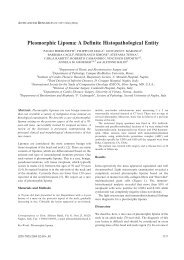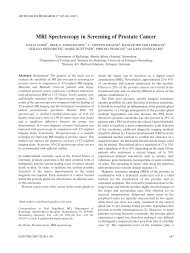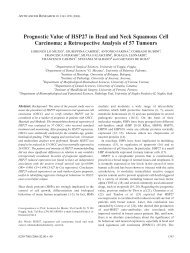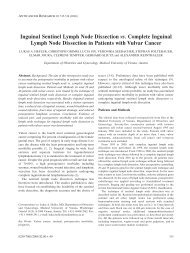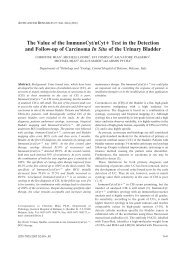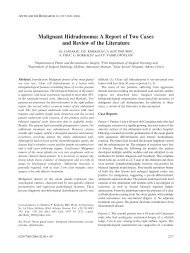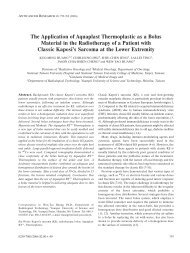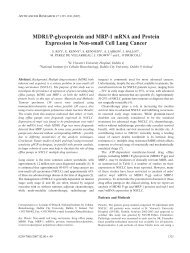ABSTRACTS OF THE 21st ANNUAL MEETING OF THE ITALIAN ...
ABSTRACTS OF THE 21st ANNUAL MEETING OF THE ITALIAN ...
ABSTRACTS OF THE 21st ANNUAL MEETING OF THE ITALIAN ...
You also want an ePaper? Increase the reach of your titles
YUMPU automatically turns print PDFs into web optimized ePapers that Google loves.
incidence and characteristics of delirium in patients >70 years<br />
old hospitalized for elective surgical urology care. Patients<br />
and Methods: For this study, which is ongoing, elderly<br />
patients for which a surgical urology procedure has been<br />
planned are enrolled. A complete evaluation by geriatrician<br />
with CGA, urologist, and anesthesiologist is applied before<br />
hospital admission. During hospitalization nurses apply a<br />
confusion assessment method daily to define the incidence<br />
and clinical characteristics of delirium. Follow-up is planned<br />
at one and three months and one year after discharge to<br />
evaluate global health and, specifically, functional and<br />
cognitive status. Results: The study includes 37 patients,<br />
(81% male, 19% female, mean age 78.1±4.5 years). Among<br />
them, 33% were affected by benign prostatic hyperplasia;<br />
22%, 26%, 15% by prostate, blood and kidney cancer,<br />
respectively, and 4% with a non-cancerous urinary tract<br />
obstruction. Mean anesthesiologist ASA score was 2.14±0.77,<br />
41% of patients underwent general anesthesia and 59% spinal<br />
anesthesia. Overall, cognitive performance was mildly<br />
impaired (MMSE: mean 24.6±4.3); 17% of patients<br />
developed post-surgical delirium; in this sub-sample, the basal<br />
mean MMSE score was significantly lower, whereas no<br />
significant differences were found with respect to basal scores<br />
of depression and disability domains. Conclusion: In our<br />
sample, the incidence of delirium was lower than expected.<br />
This may be due the selected population having low comorbidity,<br />
mild cognitive decline and a low rate of<br />
complications after the surgical procedure. It was not possible<br />
to fulfill the purpose of the study completely, but we feel<br />
confident that future sample enlargement will allow the<br />
definition of a risk-profile population that might benefit from<br />
specific programs devoted firstly to preventing the<br />
development of delirium and secondly to early treatment.<br />
1 Inouye SK: Delirium in older persons. N Engl J Med<br />
354(11): 1157-1165, 2006.<br />
2 Inouye SK, Bogardus ST, Charpentier PA et al: A multicomponent<br />
intervention to prevent delirium in hospitalized<br />
older patients. N Engl J Med 340(9): 669-676, 1999.<br />
18<br />
MANAGEMENT <strong>OF</strong> SMALL RENAL CANCER<br />
IN A CONTEMPORARY SERIES <strong>OF</strong> PATIENTS<br />
WITH VON HIPPEL-LINDAU DISEASE<br />
Paolo Destefanis1 , Barbara Lucatello2 , Mauro Maccario2 ,<br />
Andrea Veltri3 , Barbara Pasini4 , Mariateresa Carchedi1 ,<br />
Andrea Buffardi1 , Francesco Travaglini1 ,<br />
Antonino Battaglia1 , Alessandro Bisconti1 ,<br />
Andrea Bosio1 , Beatrice Lillaz1 and Dario Fontana1 1Divisione Universitaria di Urologia 2, 2S.C.D.U. Endocrinologia, Diabetologia e Metabolismo and 3Istituto di<br />
1820<br />
ANTICANCER RESEARCH 31: 1807-1956 (2011)<br />
Radiologia, Ospedale San Giovanni Battista Molinette,<br />
Torino, Italy;<br />
4 Dipartimento di Genetica, Biologia e Biochimica, Università<br />
degli Studi di Torino, Torino, Italy<br />
Background: Von Hippel-Lindau (VHL) disease is an<br />
autosomal dominant, inherited syndrome that occurs in 1 in<br />
35,000 births. VHL is characterized by the development of<br />
retinal and CNS hemangioblastomas, pheochromocytomas,<br />
pancreatic neuroendocrine tumors, clear-cell renal carcinomas<br />
(RCC) and renal cysts. In particular, RCC occurs in<br />
approximately 40% of patients affected by VHL disease and<br />
is often bilateral and multifocal. The treatment of these<br />
patients, which usually relies on nephron-sparing surgery, is<br />
often very complex. The introduction of minimally invasive<br />
techniques can simplify and improve the management of renal<br />
lesions in these patients. We report our results in a recent<br />
series of patients in a multidisciplinary clinical care center,<br />
established at our hospital. Patients and Methods: From<br />
January 2000 to October 2010 a total of 22 patients affected<br />
by VHL disease were followed at our center. Twelve patients<br />
(57%) experienced at least one RCC before or during the<br />
follow-up period. Patients were preferentially offered<br />
percutaneous radiofrequency ablation (RFA). A lesion size<br />
greater than 4 cm at a site unreachable percutaneously was<br />
considered to be a contraindication to treatment. Cystic<br />
carcinomas were not considered a contraindication. The<br />
following data were retrospectively reviewed: medical history<br />
before coming to our center, features of the lesions (size,<br />
location and number), co-morbidities, oncological follow-up<br />
and renal function before and after the treatment. Results:<br />
From January 2000 to October 2010 a total of thirteen lesions<br />
were treated in eight patients. Another patient recently<br />
experienced two small lesions (12 and 10 mm) that are still on<br />
‘wait and see’. The mean age was 44 (range 19-65) years. Six<br />
patients had a history of previous contralateral radical<br />
nephrectomy and five patients had already undergone one or<br />
more partial nephrectomies. Eight lesions were easily treated<br />
with percutaneous RFA. The mean size of the lesion was 2.57<br />
(range 1.5-3.5) cm. No complications were recorded. In one<br />
patient, a lesion of the upper pole of the left kidney, not<br />
percutaneously reachable, was treated through a laparoscopic<br />
RFA procedure. The other four patients underwent open partial<br />
nephrectomy (1 patient) or radical nephrectomy (3 patients).<br />
All patients that underwent RFA achieved a complete response<br />
and no worsening of renal function was recorded. No<br />
recurrence was recorded, with a mean follow-up for RFAtreated<br />
lesions of 32.7 (range 5-76) months. Discussion and<br />
Conclusion: Patients affected by VHL disease require a<br />
multidisciplinary approach for the various and severe<br />
manifestations of this syndrome. RCC in VHL occurs in<br />
younger patients, and is very frequently multifocal, bilateral<br />
and recurrent. For these reasons, oncological safety should not



